The Campo di Santa Giustina in Venice appears empty and uninteresting to the casual passers-by today.
I write passers-by because nobody in their right mind would bother to stop there. There’s nothing in the square, except a fairly normal Venetian well-head, and they’re all over the city.
It wasn’t always so, and, in fact, it still isn’t so, if one scratches the surface a bit.
It is one of the few Venetian campi still dominated by the presence of the canals. All the Venetian campi had some kind of access to the waterways, but often minor canals have been filled-in, so the squares now appear detached from the canal network.
Not so with Campo Santa Giustina, which still has canals on two sides. They are the Rio di Santa Giustina to the west, and the Rio di San Francesco della Vigna to the south.
The church and Santa Giustina
The ex-church of Santa Giustina dominates the campo, occupying the entire northern side. However, due to the need for churches to be oriented east-west, the façade is on the Rio di Santa Giustina.
It is as ancient as any other church in Venice, founded in the late 600s by St Magnus of Oderzo according to ancient chronicles. More reliable sources talk of a rebuilding and reconsecration in 1219, and the entire church was rebuilt again in 1500–1501.
The Baroque façade — which has only partially survived to our times — was erected in 1640 at the expense of the noble Soranzo family. It was designed by Baldassare Longhena.
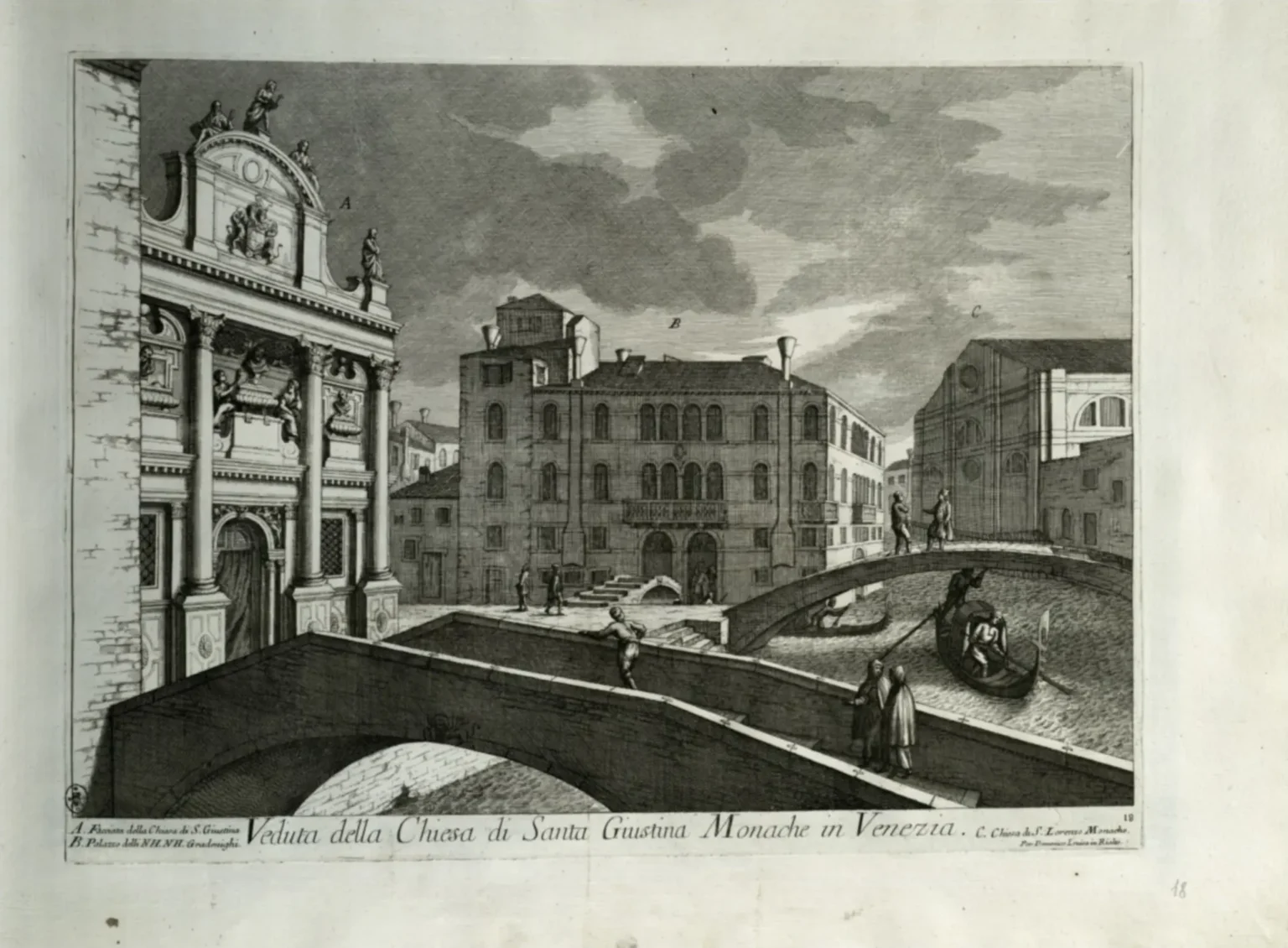
Santa Giustina is a local saint, from Padua, where her main sanctuary is.
Her feast day is October 7th.
It so happened, that the naval battle of Lepanto — one of the decisive battles of the 4th Ottoman-Venetian war (1570–1573) — was fought and won on October 7th, 1571.
Naturally, the victory was ascribed to the intervention of Santa Giustina, and for the next over two centuries, each year on October 7th, the Doge of Venice and the Signoria, arrived by boat to Santa Giustina for a solemn mass.
The campo wasn’t paved until 1749, and even then, only partially, on the part in front of the church, for the annual visit of the doge.
Like dozens of other Venetian churches, it was suppressed in 1810. The Baroque tympanum and all the statues on the façade were removed and sold, as was everything of value inside.
During the Austrian domination, it was used for a military academy. Inside, it is now divided in three floors, and serves as library for a high-school.
Palazzo Gradenigo
Opposite the church, across the canal, stands Palazzo Gradenigo. The Gradenigo was one of the most ancient Venetian noble families, listed among the case vecchie, who were ruling Venice already before the year 800.
The family had several branches, and this was the palace of the Gradenigo di Santa Giustina.
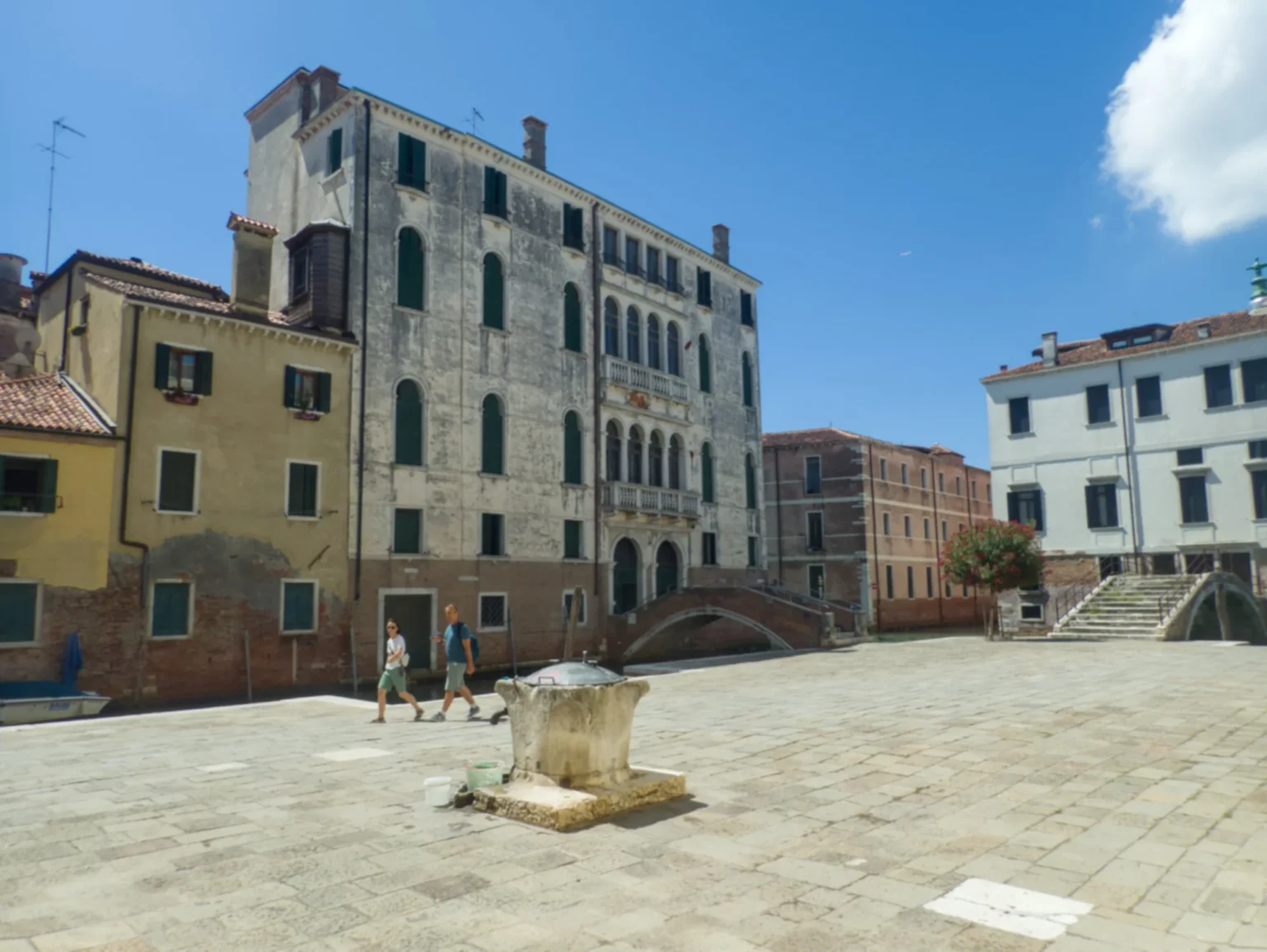
One of the best known members was Pietro Gradenigo (1695-1776), who was very much a child of the enlightenment. He collected books and art, studied, and for several decades he employed a young artist of Dutch descent, Giovanni Grevembroch (1731-1807), to paint and draw all sorts of things.
Over those years, Grevembroch produced several thousands of watercolours of just about everything in Venice. Many of these are of altars, artworks and architectural details from churches and other buildings, which, like Santa Giustina, were suppressed and despoiled of all valuables during the reign of Napoleon, and at times demolished.
In numerous instances, the watercolours by Grevembroch are our only sources to what were in these Venetian churches and monasteries before they were destroyed.
Six hundred such watercolours documented how the Venetians dressed in the mid-1700s. They were published in four volumes, and reprinted in recent times.
The Gradenigo di Santa Giustina died out in the mid-1800s. The last of the line bequeathed everything to the Municipality of Venice. The vast library and archive of Pietro Gradenigo, and the many watercolours by Giovanni Grevembroch, are therefore in the municipal Museo Correr, and the palace is owned by the city. There used to be offices, but it currently stands empty and unused.
Andrea Gritti
On the side of the façade of the church, a faint drawing in dark red can be discerned. Most people just walk by, without noticing anything.
In a red frame, there are three letters W, which is short for viva! — long live! — and a corno ducale — the ceremonial hat of the Doge. Below, enough remains of the name ANDREA to identify it. Two other lines are so eroded they cannot be read.
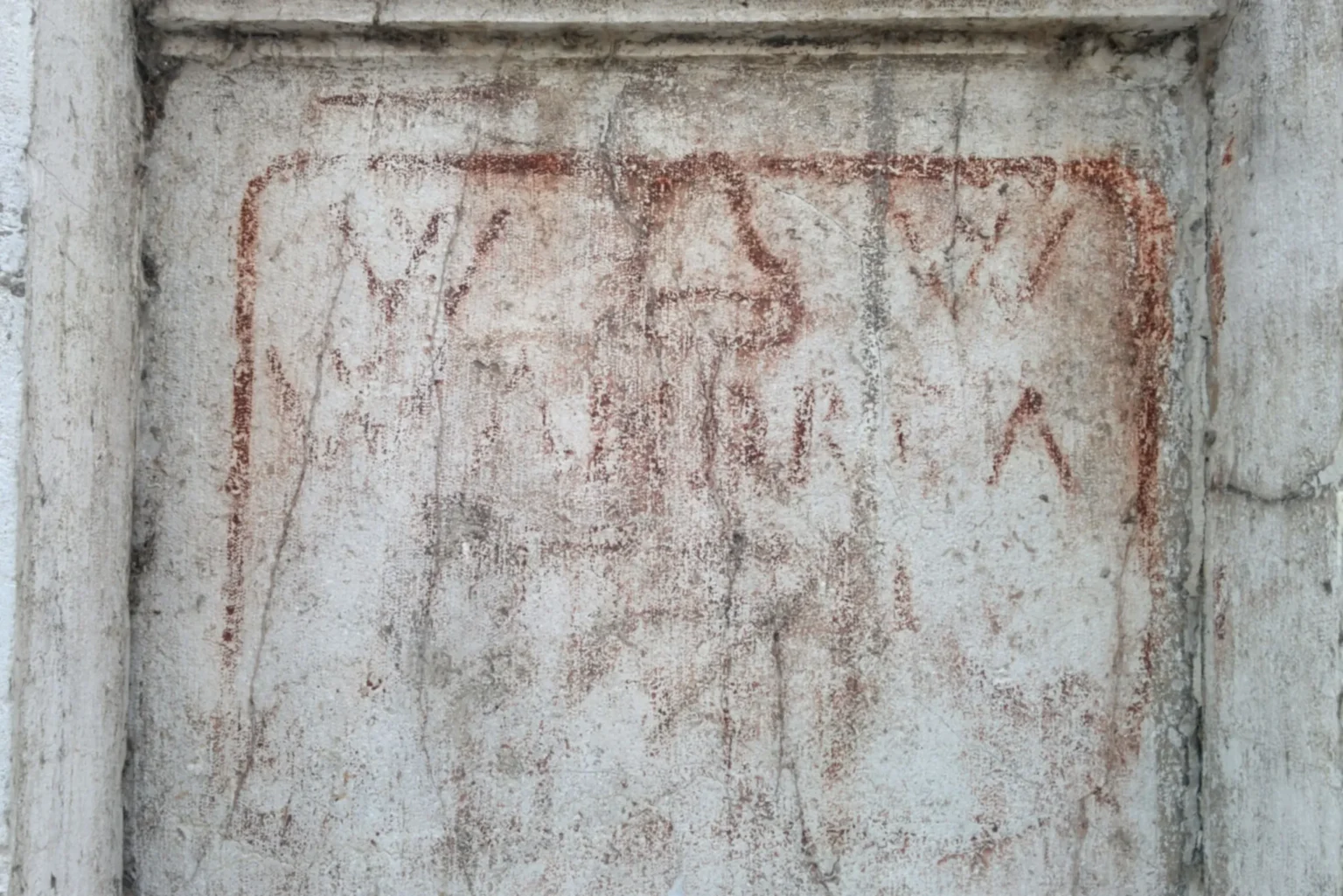
Nevertheless, joining a few dots, we can deduct a bit.
“Viva!” means a celebration, and the hat refers to a doge, so probably the creation of a doge named Andrea.
It so happens that there were only four doges named Andrea. However, the wall was built in 1500–1501, which excludes the first three, leaving only Andrea Gritti (1455-1538), who was elected doge in April 1523.
He lived in what is now the Gritti Palace Hotel on the Grand Canal, but the Gritti owned properties in the area of Santa Giustina.
Personally, my guess is, that the unreadable lines are “GRITTI” and “DUX”.
Anybody, who’ve been to Pompeii, will have seen the many writings on the walls. In a world without mass-media, writing on walls was an efficient way of getting a message out to a wider public.
In most cases, such writings have disappeared, also because they were not meant to last.
The colour was a mixture of ground brick, rust and water. Materials, which are cheap and readily available. In normal conditions, wind and rain would eliminate such a writing in a matter of weeks. However, if the writing was covered up or otherwise protected, a slow chemical reaction can bind the iron-oxide (rust) to the calcium in the stone, and make the writing permanent.
The traghetto
The Campo di Santa Giustina has two sets of steps on the two canal sides.
They were made to make it easier to get in and out of gondolas, regardless of the level of the tide.
These steps are significant because the Campo di Santa Giustina was a traffic hub.
Venice at the times of the republic had far fewer bridges than today. Often, it was difficult, or even impossible, to walk from one place to another. The land-based road network of ancient Venice was not made to be interconnected. It was only for local use.
The main road network of Venice were the canals, so boats were essential, and integral to Venetian culture.
Not everybody had their own boats, so there were taxi services available all over the city. They were called traghetti (ferries) and one of them was the Traghetto di Santa Giustina.
The steps were made to facilitate the work of the traghetto and so were the two public bridges in the campo, which are both ancient.
The rowers, who operated the traghetto, were organised in a confraternity with a mariegola, a combined statute and licence to operate.
Obviously, their patron saint was Santa Giustina, and for their private worship, they created the shrine on the wall next to the Ponte del Fontego.
Underneath the shrine, there is an inscription dated 1621, and a relief with two gondolas.
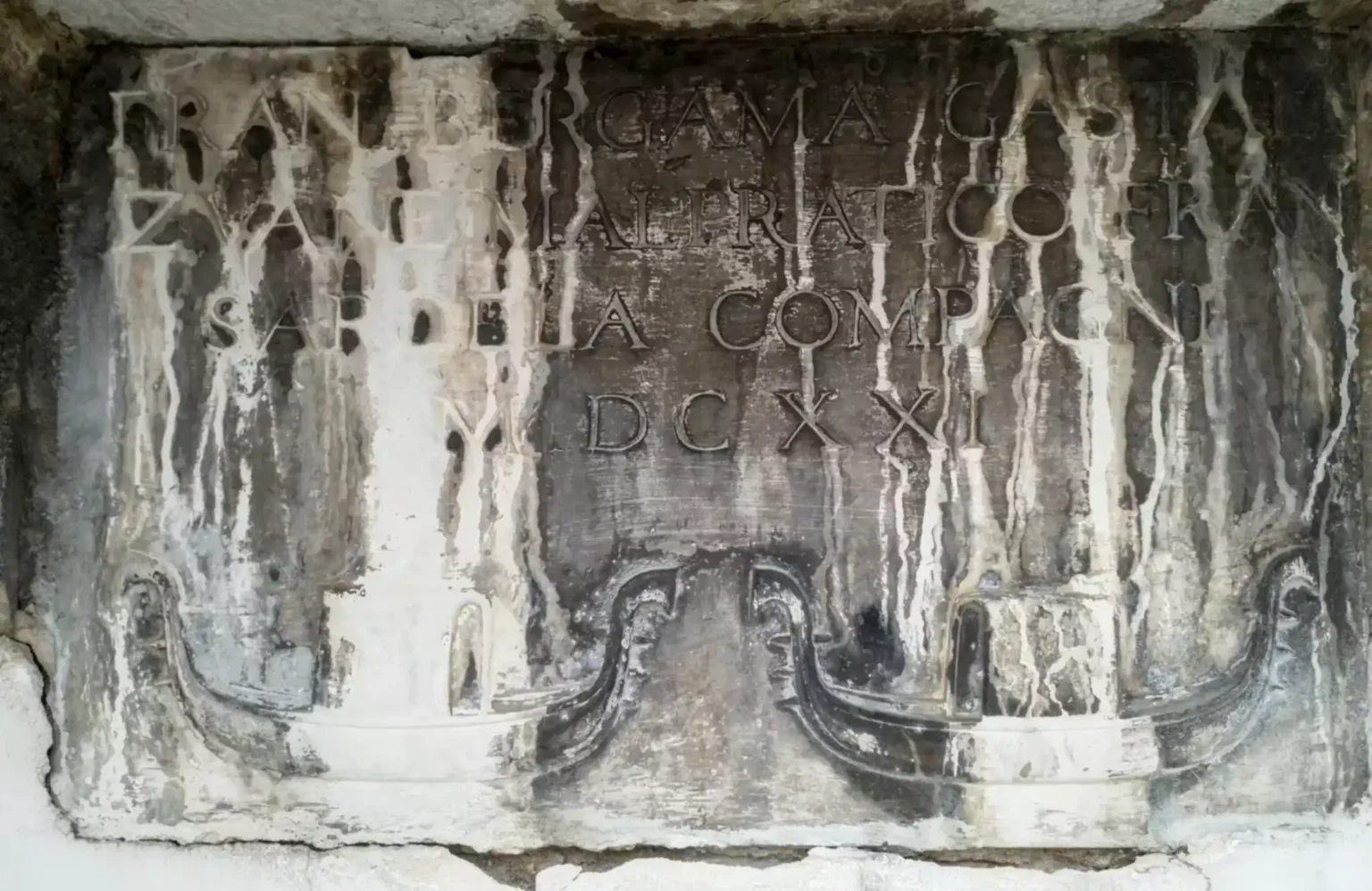
The gondolas look rather different from their modern descendants. They have a cabin, called a felze, so passengers were protected from the weather and from curious eyes. They also have two ferri, both front and back, and the ferri only have three teeth.
Gondolas in the past were far more varied than they are today.
This newsletter has become much too long, and all because of a square where nobody ever stops.
It has been said, that in Venice every stone tells a story, and it is not entirely untrue.
Bibliography
- Grevembroch, Giovanni. Gli abiti de veneziani di quasi ogni eta con diligenza raccolti e dipinti nel secolo XVIII, orig. c. 1754. Venezia, Filippi Editore, 1981.
- Lovisa, Domenico. Il Gran teatro di Venezia ovvero descrizzione esatta di cento delle più insigni prospettive, e di altretante celebri pitture della medesima città, il tutto disegnato, e intagliato eccelentemente da periti artefici, con la narrazione della fondazione delle chiese, monasteri, spedali, isolette, e altri luoghi sì pubblici, come privati. Venezia per Domenico Lovisa sotto i portici a Rialto, 1715. [more] 🔗
- Tassini, Giuseppe. Curiosità Veneziane ovvero Origini delle denominazioni stradali di Venezia. 1863. 🔗

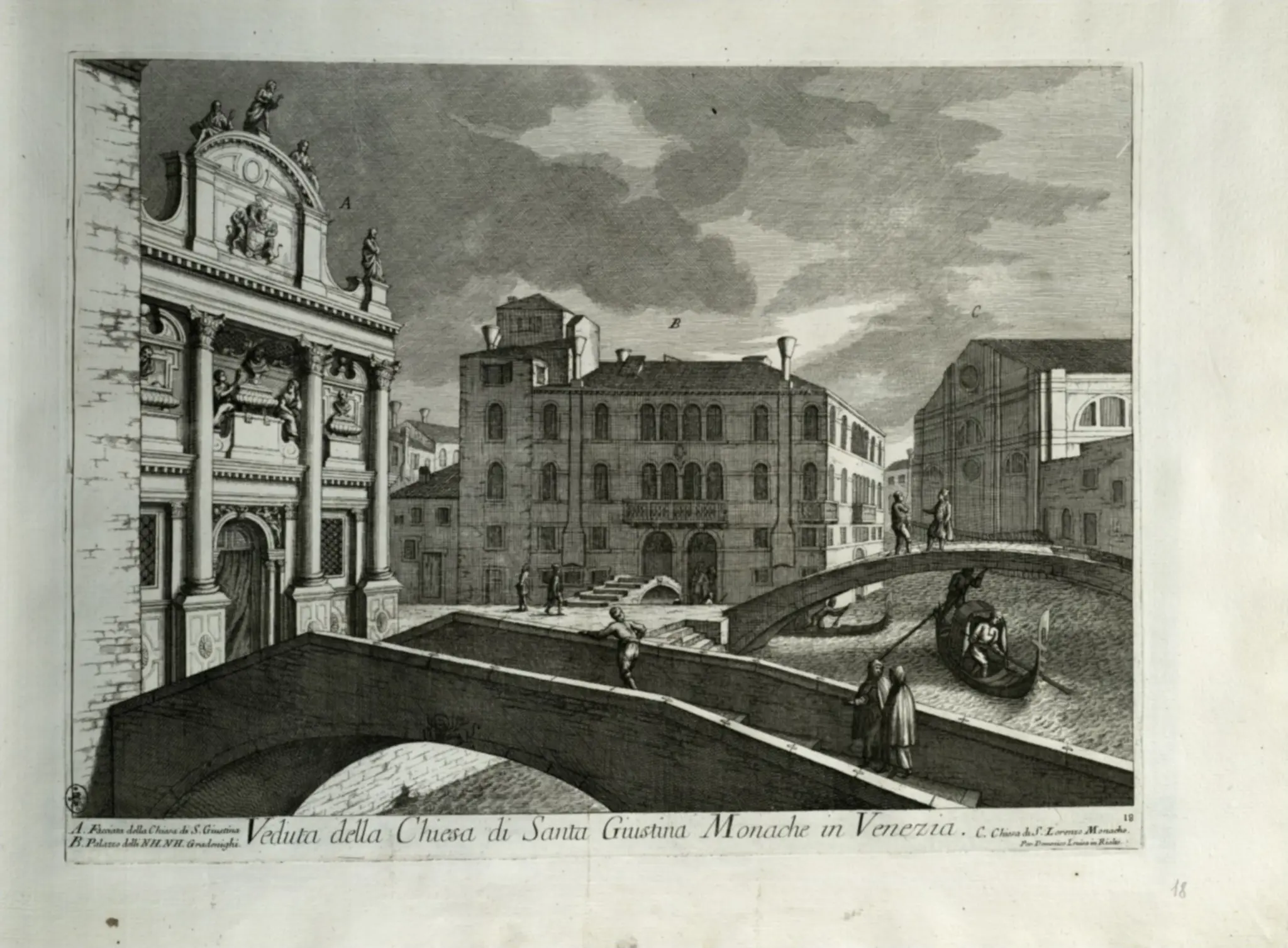
Leave a Reply